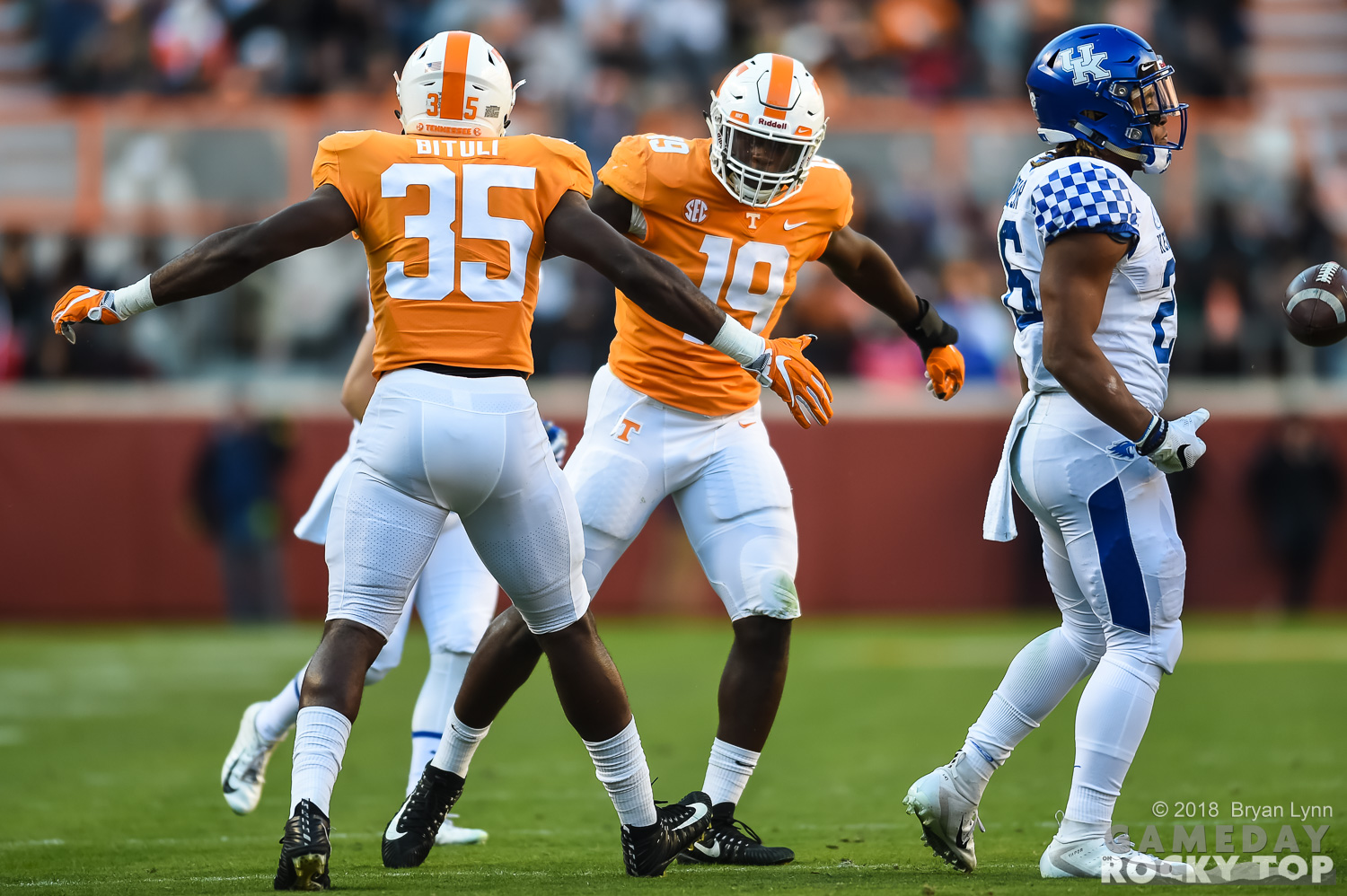Last summer we looked at five ways Tennessee could show the most improvement in 2018. As was the case with much of last season, progress was present but not in a hurry: Tennessee improved its third down conversation rate from 30.67% to 38.22%, but the other four categories still have plenty of room to grow.
This summer we’re diving deeper into the places Tennessee has the most room for improvement in 2019 with our Making Progress series, starting today with getting the ball back.
Rocket Science, etc.
How many times did Tennessee force more than one turnover last season? One was ETSU. The other two? You guessed it: Auburn and Kentucky. In the other nine games, the Vols forced a single turnover six times, and had the goose egg thrice (UTEP, Georgia, Vanderbilt).
It wasn’t just the volume, but the timing of turnovers in Tennessee’s win at Auburn:
- Auburn leading 10-3 2Q, Bryce Thompson INT at the UT 41, leads to UT touchdown.
- Game tied 10-10 2Q, Jonathan Kongbo trick play INT from the UT 36
- Vols leading 20-17 3Q, Sack-Fumble-TD
The Vols built their 24-7 lead over Kentucky with no assistance, then watched the Wildcats give it away three times in the final 10 minutes, twice inside the Tennessee 35, to prevent any idea of a comeback.
In a sense, it was the opposite problem from 2017. The Vols used a pair of turnovers to get the Georgia Tech game to overtime, but couldn’t beat the Gators despite three turnovers and lost at Kentucky despite a +4 margin. The offense failed to be opportunistic in 2017, then opportunity knocked only twice last fall.
The result: just 15 turnovers in each of the last two seasons, 97th nationally in 2017 and 101st in 2018 (stats via SportSource Analytics). That total joins anemic defenses from 2011 (18 turnovers), 2012 (17), and a what-could-have-been unit from 2015 (19 turnovers) in Tennessee failing to break 20 turnovers five times in the last eight years.
What makes the difference here? In 2017 the Vols recovered more fumbles, picking up ten loose balls with only five interceptions. Last year the Vols almost doubled their INT output with nine, plus six fumble recoveries. Both times the Vols recovered two-thirds of the fumbles they forced, meaning these numbers could’ve been even lower.
Who are the difference makers?
Bryce Thompson had three interceptions last year, Marquill Osborne two in those final ten minutes against Kentucky. Tennessee’s other interceptions last season came from the front seven: Kongbo against Auburn, Darrin Kirkland Jr. against ETSU, Kyle Phillip’s Piesman-winning play against Alabama, and Shy Tuttle had one at South Carolina.
It’s a little thin on the secondary, but I think we all feel pretty good about Thompson, Alontae Taylor, and Trevon Flowers continuing to grow back there. A big piece of this puzzle isn’t just the right guys covering receivers, but making a difference earlier in the play.
SB Nation’s Bill Connelly likes to point out that sack rate is the most reliable statistic when it comes to projecting a team’s turnover margin: the more often you hit the quarterback, the more likely you are to produce both fumbles and bad decisions that become interceptions. Last season the Vols averaged 2.08 sacks per game, 68th nationally. Eight of those 25 sacks came from Darrell Taylor, seven against Georgia and Kentucky. Like most things, it was an improvement over 2017 (22 sacks), but fell behind what the Vols accomplished in the Derek Barnett era (30 sacks in 2015 and 2016, 35 when Barnett and Curt Maggitt played together in 2014).
Something else to consider here: opposing quarterbacks completed 63% of their passes against Tennessee last year, 103rd nationally for the Vol defense. Some of it was who the Vols faced:
| QB | Cmp | Att | Pct | Yds | YPA |
| Will Grier | 25 | 34 | 73.5 | 429 | 12.6 |
| Jake Fromm | 16 | 22 | 72.7 | 187 | 8.4 |
| Tua Tagovailoa | 19 | 29 | 65.5 | 306 | 10.6 |
| Drew Lock | 21 | 30 | 70.0 | 257 | 8.6 |
…but then Kyle Shurmur went 31-of-35 (88.6%) for 367 yards and 10.5 per. No other team completed more than 80% of their passes against the Vols this decade; Shurmur flirted with 90%.
So, as is the point with this series, lots of room to grow. For Tennessee to turn progress into progress! in 2019, they will almost certainly need more turnovers. Some of it is luck, some of it maturation in the secondary. But Tennessee also has to be better at disrupting the passer, and giving itself more of a chance to make a play.
